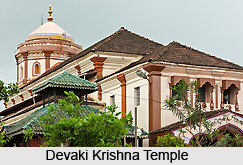 Devaki Krishna Temple is located in Marcel, Goa. The temple houses other deities like Bhumika Devi, Laxmi Ravalnath, Mallinath, Katyayani, Chodaneshwar and Dhada Shankar other than Devaki and Krishna. Originally the temple was located at Chorao Island. Later it was moved to Mayem in Bicholim and thereafter it was finally reconstructed in its present place beside the Banastari Bridge.
Devaki Krishna Temple is located in Marcel, Goa. The temple houses other deities like Bhumika Devi, Laxmi Ravalnath, Mallinath, Katyayani, Chodaneshwar and Dhada Shankar other than Devaki and Krishna. Originally the temple was located at Chorao Island. Later it was moved to Mayem in Bicholim and thereafter it was finally reconstructed in its present place beside the Banastari Bridge.
Lord Krishna is depicted as a small child sitting in between Devaki`s legs. This temple is also called the Pisso Ravalnath temple to the locals. The major festival celebrated is the
Malin Purnima from Paush Vadya. It is celebrated during January and February. Other festivals celebrated in the temple are Navaratri festival, Gokulastami, Ramanabami, Shri Chandika Yaina and the anniversary of the temple.
This article is a stub. You can enrich by adding more information to it. Send your Write Up to content@indianetzone.com











